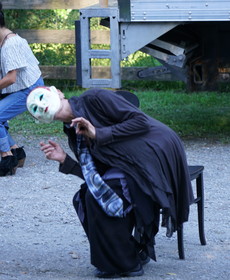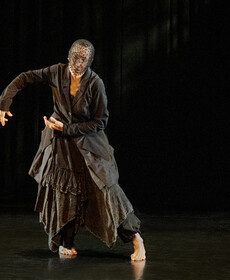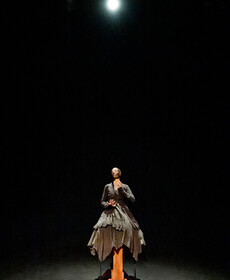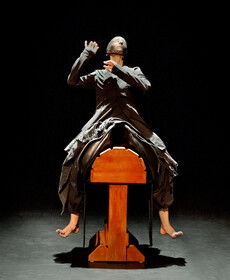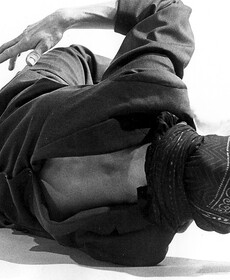THE SOLOS: Of This Body
That still feels like the most important guidance.
OF THIS BODY
is an multi-disciplinary dance theater project conceived, choreographed and performed by Paula Josa-Jones in collaboration with her design team. OF THIS BODY integrates projection and lighting, set and costume design to create seusual worlds that draw the audience deeply into the physical and emotional currents of the dance. Projections are a seamless element of the choreography, another character in the space. The digital world weaves through the piece alongside the performer, transporting the audience to various settings, in and out of literal space, shifting the perception of time. Content ranges from rugged landscapes to unique structures, metaphorical imagery to a distinctly present secondary character. The figures in the video fade into and out of the changing landscapes in constant conversation with the live performer. SPEAK (2016) springs from questions about language and the absence of language in its usual form. It is about obsession and excavating meaning from the body when words cannot be shaped. SPEAK is inspired by 17 years of working with my profoundly autistic godson and physical research into aphasia, apraxia and synesthesia. THE TRAVELER (terra incognita) (2016) is set in a turbulent landscape of crumpled and suspended archival maps, explores how unpredictable, volatile change can fracture our sense of self and disrupt our bodies. Inspired in part by W.S. Merwin's surreal Book of Fables, it asks what it means to find oneself in terra incognita, not once or twice, but throughout our lives. Set to music by Hugues Le Bars and a sound score by Josa-Jones, the traveler navigates perilous topographies, finding and losing balance as physical and dream terrains shift and buckle. CAVALLUS (2022) explores the bio-synchrony of horse and human in the language of hoof and foot, presence and absence, movement and stillness. It is inspired by the death of Paula's beloved stallion Capprichio, and the poem "My Hunger" by poet Jane Hirshfield:must carry a pole
to make her arms longer
you carried me
I carried you
through this world.
Projection Design: Katherine Freer
Set Design: Paula Josa-Jones and Christine Joly de Lotbiniere
Lighting Design: Susan Hamburger
Costume Design: Christine Joly de Lotbiniere
Photography: Pam White
Director/Outside Eye: Paola Styron.
OTHER SOLOS
OFRENDA (1996) Set to music by Robert Ashley, Josa-Jones developed this solo while in residence in Mexico, creating Ghostdance with Pauline Oliveros, based on images of the Dia de lor Muertos. The body is the ofrenda (offering), a reliquary of wilting flowers, stories, memory, and the voices of ancestors. THE MESSENGER (1992) is a dance in which two characters, one male, one female, vie for occupation of the same body. They speak in many voices: signing, tapdance, tongues, and a whole-body iconography that threatens to rend the body. The ending holds taut the thread of gender ambiguity. As with many of Josa-Jones's dances, the opening shot of The Messenger - created for the choreographer- a black umbrella, and a chair, hits like a thunderbolt. A bearded Josa-Jones, clad in voluminous black raincoat, top hat and glasses, sits with one arm outstretched, her had resting atop the hook of the umbrella handle. She rises and slowly traverses the stage apron, her extended, twitching fingers charged as an electrical storm. She looks long and lean enough to connect floor to ceiling. she projects enough power to change the course of human events.The Boston Phoenix MOTH (2019) is part of an ongoing series of solos that explores the relationship of the animal self to other species. It was inspired by finding a moth on the screen of my studio. Its wings had frayed almost beyond recognition, but was nonetheless flying, continuing its journey. Dancing in my own fraying body, I am curious about impermanence, courage, fragility and potency. I found this in my research: "It is revealed by Don Juan, a Yaqui sorcerer, "the moths carry a dust on their wings, a dark gold dust. That dust is the dust of knowledge. Knowledge comes floating like specks of gold dust, the same dust that covers the wings of moths." DRINK THIS (2017) is a journey down the rabbit hole of gender fluidity and the cataclysmic flooding of bodily fluids. Music by Deirdre Broderick; score by Paula Josa-Jones. RAVING IN WIND (1997) lives in the hollow boned, winged world of birds and the ecstatic madness of unexpected flight. It is inspired by Ann Lauterbach's poem Rancor of the Empirical. Commissioned score by Ingram Marshall and video by Ellen Sebring. CALLIOPE (2018) set to music by Gaelynn Lea in a score by Paula Josa-Jones. In Greek mythology, Calliope is the muse of epic poetry. A calliope is also a musical instrument that produces sound by sending steam through whistles. Imagined as a gender fluid Pierrot character, CALLIOPE is a whimsical dance of transformation, invocation and remembrance. This dance can be performed in any theatrical or outdoor venue, including buses, trains and ships. CARNE VALE (1999) grew from a character who appears in the video dance DIVE, the character is trickster and a who invites viewers into an underground carnival with sleight of hand and body. First performed in St. Petersberg, Russia.
Download more information about OF THIS BODY
Read Marcia B. Siegel's review of OF THIS BODY
REVIEWS
The curtain rises on a a ghostly horse: a saddle crafted atop a half-barrel with wheels. Josa-Jones, dressed in gray jacket, long, layered skirt, and ballooning leggings, accented by a black veil across her face, mounts the steed. The air is thick with mourning; it's as if we're looking at the dance at dusk. The soundscape, by Fred Frith, is discordant, full of gongs and shuddering strings. As Josa-Jones manipulates the horse around the space, she executes odd, haunting movements: sitting upright, her bent knees rise to her chest, her hands clutch as if pulling at heartstrings, her bare feet jitter. She is saying goodbye, gently while also acknowledging, to herself and us as her witnesses, that Capprichio will be with her, and through her work with us, forever.Thea Singer, Arts Fuse As far as I am concerned, Paula Josa-Jones walks on water. I just this eve saw her perform a solo piece [SPEAK] at Joe's Pub in NYC. Part of an eve of out-of-the-box dance presentations. Some of the pieces were still struggling to get out, but Paula's piece was way out. A totally original character who expresses itself through movement, with every part of its body and appendages going in different directions simultaneously. I am saying this because while her creation is androgynous, it is not at all asexual. This character grabs you right in the gut on many different levels. I could go on and on.
Evangeline Johns, Actor It is not an overstatement to say that the two people at my table at Joe's Pub and I were riveted by your performance [of SPEAK]. It was stunning, moving, complex. Thank you.
Megan Nicely, Dancer/Artist, Associate Professor, University of San Francisco Paula's work is a virtuosic exploration of character and movement detail. She creates mysterious and startling solos which are reminiscent of the portrait work of photographer Diane Arbus. This work is fresh and challenging, pushing at the parameters of dance to create an exciting new form.
New England Arts Biennial/Advocate In Doorway, a section of THE TRAVELER, Josa-Jones is imprisoned in her body. She interacts with a video of a brick wall and a closed door, scratched with graffiti. We viewers feel locked out as the dancer attempts to move the wall; she wills her body to push against it, but the wall does not move. The dreamlike performance becomes myth.
Carol Dine, Writer, author of Places in the Bone You transcend age and you transcend gender!
Peter DiMuro, Executive Director, The Dance Complex, Cambridge, MA THE MESSENGER gets more subtle and complex every time I see it. You seemed truly torn between your desire to be both man and woman and were at one and the same time both. The movement phrases are like complex sentences full of adjectives and metaphors echoed by lip and ankle and shoulder - never truncated, never cut off. The image I got when your fingers started signing in the middle of your belly was of a nebula whirling from your belly with long arms of energy flying off at intervals.
David Miller, High Performance I've consistently been impressed with the subtlety of articulation she achieves; her ability to embody distinct states of being through movement which seems planned but not choreographed, and is neither classically shaped nor task-oriented. It is a matter of summoning personas and being empty enough at the core to let them live.
High Performance Paula Josa-Jones comes to dance by way of theater and has garnered strong virtuosity in heightening impact through the evaluation of small action. She has a keen awareness of the sources of comedy in theater: the use of timing for surprise, patience with the simple task, solemn obliviousness to seeing oneself through the eyes of the world. I shall not soon forget the rapt attention of Josa-Jones arranging eight or so carrot slices on a napkin as though on a chess grid, then maniacally rearranging them to determine - by some delusional scale of values - in what order to eat them.
The Berkshire Eagle About Ofrenda:
The opening image in OFRENDA is riveting. The colors of your costume, your profile, were at once a painting by Frida Kahlo and a portrait on an ancient Egyptian frieze and you the leader in the procession bringing gifts to the gods.
Juan Alonso, Killing the Mandarin The most danceable work, and the most appealing came from Paula Josa-Jones. In the provocative solo OFRENDA, Jones was gorgeous as a creature seemingly possessed by spirits not of this world. Angular, sculptural posturing was sumptuously fluid, with Jones' arms alternately reaching, enfolding, beseeching, sometimes seeming to turn back on themselves as she slowly traversed the space in this unsettling and riveting work.
Karen Campbell, The Boston Herald As if a hybrid of a Pierrot and a rose, beginning in a two-dimensional silhouette, fingers splayed, she deftly and pointedly alternates between flat positions and increasingly expansive three-dimensional movement. She traverses the floor in simple patterns (and with an occasional Duncan-esque leap) that clearly define the space and her relationship to it. An almost balletic presentation of each (long) limb to the audience defines a uniquely delicate strength in the process. Ofrenda is ultimately as close to perfection as a dance can be.
T.J. Medrek In a black Victorian dress of voluminous proportions, Josa-Jones sits on a pile of bones that are revealed as she gathers the dress around her in BONE FIELD. She gathers the bones, separates them and goes about the task of putting them in order. She caresses the skull of the beast, places it between her legs in a bizarrely erotic way. She sets out the ribs, fans herself with a scapulae, twitches her own neck as she finds a cervical vertebrae. It's a puzzzle and it's funny.
Lisa Friedlander, The Boston Phoenix
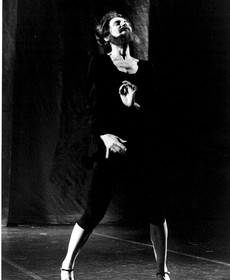
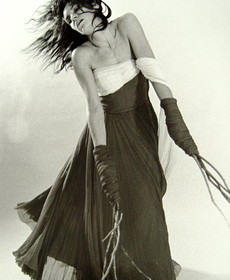

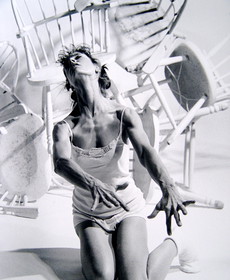
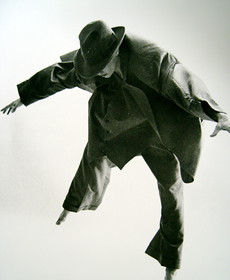
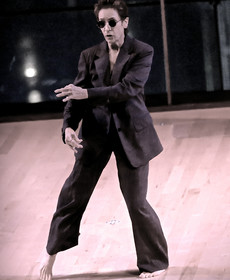
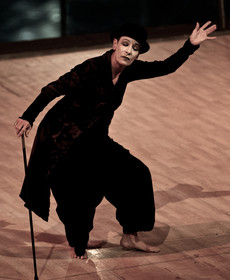
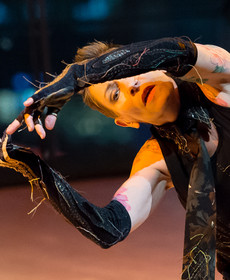
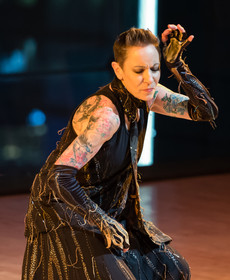
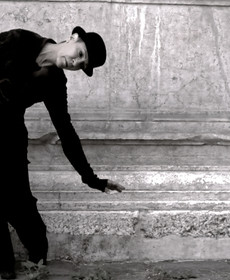
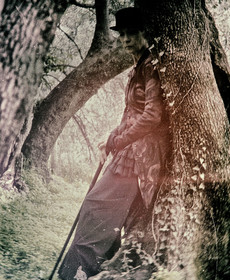
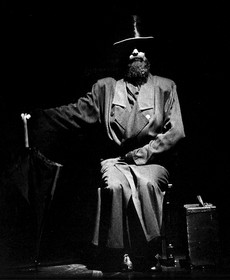
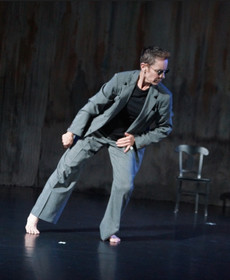
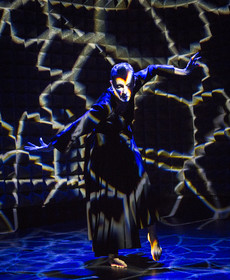
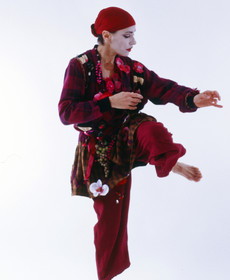
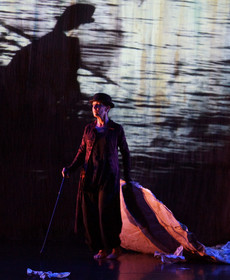
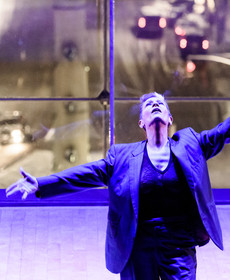
![FLUID[s] FLUID[s]](/page_images/641-photo-230-280-crop.jpg)
![FLUID[s] FLUID[s]](/page_images/642-photo-230-280-crop.jpg)
